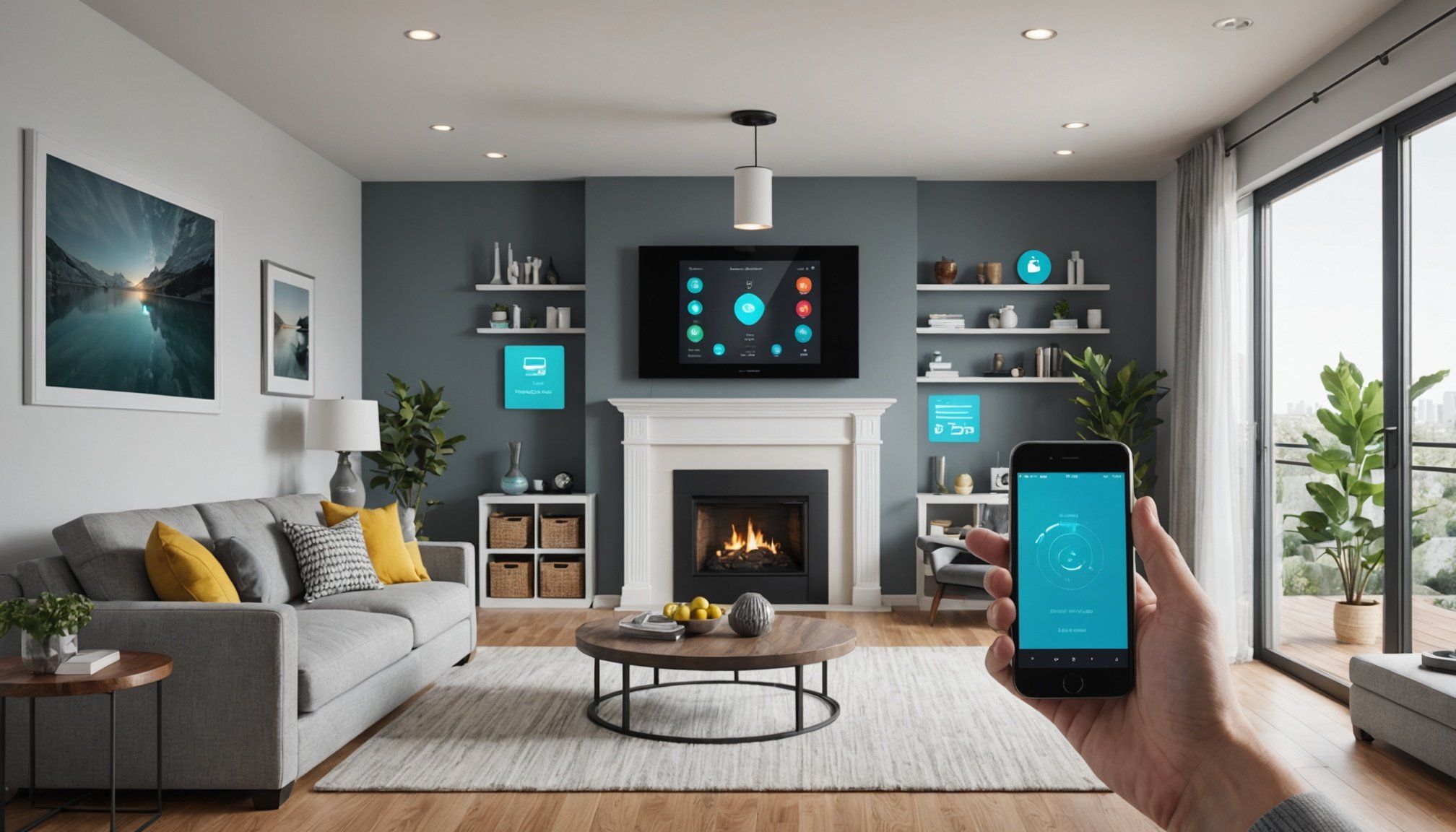The Ultimate Guide to Seamless Smart Home Automation: Monitor Your Home in Real-Time with Your Smartphone
In the era of smart technology, transforming your home into a smart home is no longer a luxury, but a necessity for convenience, security, and energy efficiency. This guide will walk you through the process of setting up and managing a seamless smart home automation system, allowing you to monitor and control your home in real-time with your smartphone.
What is Smart Home Automation?
Smart home automation involves using advanced technologies to integrate various devices and systems within your home, enabling their control and automation through interconnected networks. This innovation allows homeowners to manage aspects such as lighting, temperature, security, and entertainment systems remotely, often via a mobile app or a central home automation hub. It enhances convenience, energy efficiency, and security, making daily tasks simpler and more efficient[1][3].
This might interest you : Transform your smart home office: essential tips for streamlined equipment management using your smartphone
Key Components of Smart Home Automation
Smart Lighting
Smart lighting is one of the most popular smart home automation ideas. Imagine a gentle night light that illuminates your path to the bathroom or kitchen without blinding you. Smart lighting systems, like Philips Hue, allow you to adjust brightness, color, and even the warmth or coolness of the light to match your mood or activity. These systems can be programmed to follow your daily routine, such as brightening in the morning to wake you up gently or dimming in the evening for a relaxing atmosphere[1].
Automated Security Systems
Automated security systems are a cornerstone of smart home automation. These systems integrate surveillance cameras, smart locks, and alarm systems that you can monitor and control remotely. Smart security cameras, for example, offer high-definition video, night vision, and motion detection. Some models allow real-time streaming to your smartphone, enabling you to keep an eye on your home from anywhere. Features like facial recognition can distinguish between known residents and strangers, adding an extra layer of security[1][4].
Also to read : Turn your smartphone into a cutting-edge weather hub for precision forecasting!
Smart Devices
Smart devices are essential for home automation, offering increased convenience and efficiency in household tasks. Interconnected devices like smart refrigerators, ovens, and washing machines can be controlled and programmed remotely. They optimize resource usage, adapt to user preferences, and assist in daily tasks, making home management more fluid and comfortable[1].
Setting Up Your Smart Home Automation System
Choosing a Central Hub or Platform
The first step in setting up your smart home automation system is to select a central hub or platform that is compatible with most, if not all, of your smart devices. This could be a physical device like the eufy HomeBase S380 or Amazon Echo, or a software platform like Apple HomeKit. The hub acts as the brain of your smart home, allowing different devices to communicate with each other[1].
Using a Unified Interface
Use applications that can control multiple devices from different brands and types. Applications like IFTTT (If This Then That) allow you to create customized automations and interactions between various smart devices, enhancing their functionality and your convenience[1].
Ensuring a Solid Network Connection
A robust and reliable WiFi network is crucial for smart home devices, especially if they are spread throughout your home. Consider upgrading your router or adding WiFi repeaters or mesh networks to ensure a strong connection in all areas of your home[1].
Integrating Devices and Systems
Home Assistant: A Comprehensive Solution
For those looking for a more hands-on approach, Home Assistant is a powerful platform that allows you to integrate and control a wide range of smart devices. You can use a Raspberry Pi or the Home Assistant Green box to set up your system. Home Assistant offers native integrations and the ability to install community-driven integrations through HACS (Home Assistant Community Store), significantly expanding your automation possibilities[2].
Adding Integrations
Once you have your physical setup and have installed your smart home system, it’s time to add integrations. Home Assistant allows you to integrate various devices and services, from smart lighting to security cameras. You can also use triggers and automation scripts to make your home respond to your needs and habits seamlessly[2].
Real-Time Monitoring with Your Smartphone
Remote Control and Monitoring
One of the most significant advantages of smart home automation is the ability to control and monitor your home remotely with your smartphone. For instance, you can adjust the lighting, temperature, or security settings from anywhere, ensuring your home is exactly as you want it to be. This is particularly useful for security, as you can receive real-time alerts and view footage from your security cameras on your smartphone[3][4].
Voice Control
Voice control through assistants like Google Assistant or Amazon Alexa adds another layer of convenience. You can use voice commands to turn on lights, adjust thermostats, or lock doors, making it easier to manage your home without needing to physically interact with devices[3].
Energy Efficiency and Cost Savings
Smart Thermostats
Smart thermostats, like those from Nest or Ecobee, are designed to optimize energy consumption. These thermostats learn your schedule and preferences to adjust the temperature accordingly, reducing energy waste and saving you money on your utility bills. They can also be controlled remotely, ensuring your home is at the perfect temperature when you arrive[3].
Smart Lighting and Appliances
Smart lighting systems and appliances are also designed with energy efficiency in mind. For example, smart bulbs can be programmed to turn off when not in use, and smart appliances can optimize their energy consumption based on the load size and other factors[3].
Enhancing Security with Smart Home Automation
Smart Security Cameras
Smart security cameras are a critical component of any smart home security system. These cameras offer high-definition video, night vision, and motion detection. They can send real-time alerts to your smartphone if they detect any unusual activity, providing an added layer of security for your home and family[4].
Smart Locks and Alarm Systems
Smart locks and alarm systems can be integrated into your smart home automation setup to enhance security. These systems can be controlled remotely, allowing you to lock doors or arm the alarm system from your smartphone. Some smart locks also offer features like biometric authentication and guest access codes, making it easier to manage who has access to your home[1][4].
Practical Tips for Setting Up Your Smart Home
Plan for Scalability
When setting up your smart home, it’s important to think about future expansions. Choose a system that is scalable, allowing you to add more devices or upgrade existing ones without needing a complete overhaul[1].
Secure Your System
Ensure your smart home system is secure by using strong passwords and keeping your software and firmware up to date. Regularly update your devices and hubs to protect against potential security vulnerabilities[3].
Use Unified Naming Conventions
Use a consistent naming convention for your automations and devices to make it easier to manage and troubleshoot your system. This will help you quickly identify which device or automation is causing an issue[2].
Example Setup: Integrating Smart Devices with Home Assistant
Here’s an example of how you might set up a smart home automation system using Home Assistant:
- Hardware: Use a Raspberry Pi or the Home Assistant Green box as your central hub.
- Software: Install Home Assistant and configure it to integrate with your smart devices.
- Integrations:
- Add smart lighting systems like Philips Hue.
- Integrate smart security cameras like Netatmo.
- Connect smart thermostats like Nest.
- Incorporate smart locks and alarm systems.
- Automations:
- Create automations to turn on lights when you enter a room.
- Set up triggers to arm the alarm system when you leave the house.
- Program the thermostat to adjust the temperature based on your schedule.
Table: Comparing Popular Smart Home Hubs
| Hub/Platform | Compatibility | Voice Control | Remote Access | Scalability |
|---|---|---|---|---|
| Amazon Echo | Wide range of devices | Yes (Alexa) | Yes | High |
| Google Home | Wide range of devices | Yes (Google Assistant) | Yes | High |
| Apple HomeKit | Limited to Apple-compatible devices | Yes (Siri) | Yes | Medium |
| Home Assistant | Highly customizable, supports many devices | Yes (with integrations) | Yes | Very High |
Smart home automation is not just about installing a few smart devices; it’s about creating a cohesive system that enhances your living experience. By choosing the right hub, integrating various devices, and setting up automations, you can make your home more convenient, secure, and energy-efficient.
As John, a smart home enthusiast, puts it: “Smart home automation has changed the way I live. I can control everything from my smartphone, whether I’m at home or away. It’s not just about convenience; it’s about peace of mind knowing my home is secure and efficient.”
Final Tips and Recommendations
- Start Small: Begin with a few devices and gradually expand your system.
- Choose Compatible Devices: Ensure that the devices you choose are compatible with your hub or platform.
- Regularly Update Software: Keep your system updated to protect against security vulnerabilities and ensure optimal performance.
- Experiment with Automations: Don’t be afraid to try out different automations to find what works best for you.
By following these guidelines and tips, you can create a smart home that truly meets your needs and enhances your living experience. With the right setup, you’ll be able to monitor and control your home in real-time with your smartphone, making your life easier, safer, and more efficient.











